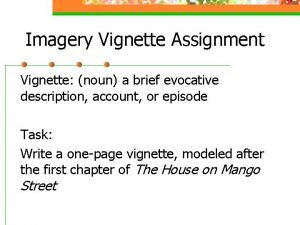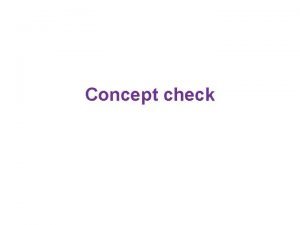WarmUp Check the vignette Read the vignette on





- Slides: 5

Warm-Up: Check the vignette ■ Read the vignette on the handout you received at the door. ■ Annotate the vignette as you go. Look for figurative language and sensory details. ■ Use the checklist to “grade” the vignette. ■ Answer: What does the vignette do well? ■ Answer: What could the vignette do better?

40 minutes ■ No plot needed. Don’t worry about an “introduction” or a “conclusion. ” Just jump right in to your “snapshot. ” ■ Include your sensory details you listed on your chart. Remember – show me, don’t tell me. ■ Include at least three pieces of figurative language. ■ Keep your paragraphs short! ■ Vary your sentence length – have some very short (even fragments) and some very long (even run-ons). ■ When you get to the end, stop it suddenly. Don’t explain what you learned or what you want the reader to learn. Just end it.

Editing/Revision – 10 minutes ■ Either switch papers with someone next to you and let them do your checklist, or do it yourself if you prefer. ■ When your checklist is finished, review it. Make at least three changes to your rough draft based on the feedback. Make them visible by adding them in a different color OR writing in the margins and drawing arrows in to your text.

Final Draft Requirements ■ **I would suggest typing your final draft in Word, to be safe. Then you can copy and paste that document onto your blog. ** ■ Use your current blog or set up a blog using weebly or wordpress. ■ Type your blog post. Make the title of your blog post the title of your vignette. ■ Find and include at least three appropriate visuals to enhance your story. ■ When you are done, publish your post. ■ Go to our class blog – yeglit. weebly. com. Hover “Advanced Composition” and click on “Student Blogs. ” Find your class period. Click on “comments. ” Add a comment with your name and the address to your published blog. Post the comment.

Blog Commenting ■ For a speaking/listening grade, you will need to visit three of your peers’ blogs, read their vignettes, and leave one positive and constructive comment about their writing. That means: 1) tell them what they did well, and 2) tell them one way to make it better. The comment must have your full name on it in order to receive the credit.









